How to Grow Parsnips for Beginners
If you want to add a few new vegetables to your summer garden, then this guide on how to Grow Parsnips for Beginners will get you off to a good start.
Gardening 101 can be done so you can grow one that is full of all the produce you love is the best way to enjoy this summer project.
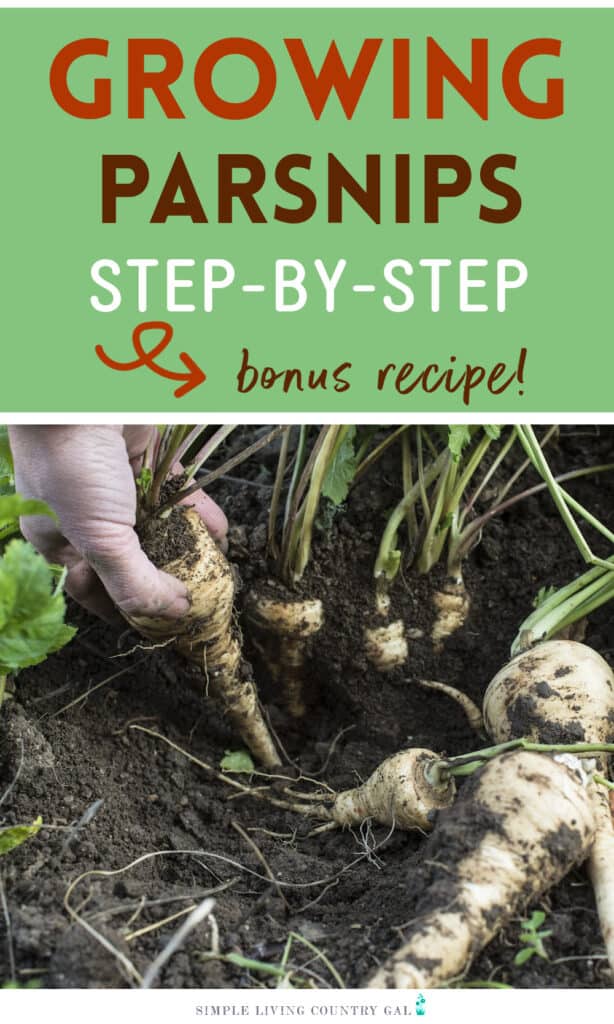
Parsnips are a tasty root vegetable with a longer growing season. Planted in the spring, they’ll benefit from a fall frost and be ready to harvest before the ground freezes. They’re great in soups, stews, and even as a side dish.
If you’re not familiar with parsnips, you’ve probably at least seen them. They look like large white carrots and they’re rich in flavor with a slightly sweet taste. They’re quite tasty and you can even make stovetop fries with them; cut into thin strips and tossed with a little salt, pepper, and olive oil then heated up in a skillet. They can be a healthy addition to any meal.
Parsnip Fries Recipe
- Preheat oven to 425
- Place parchment paper on a baking sheet
- Peel about 1-2 pounds of parsnips
- Cut into 3 inch strips
- Drizzle with olive oil
- Sprinkle with salt, pepper, and garlic powder
- Place seasoned parsnips in a single layer on baking sheet
- Roast for 15 minutes
- Turn parsnips over
- Roast another 10-15 until golden brown
- Enjoy with your favorite dipping sauces
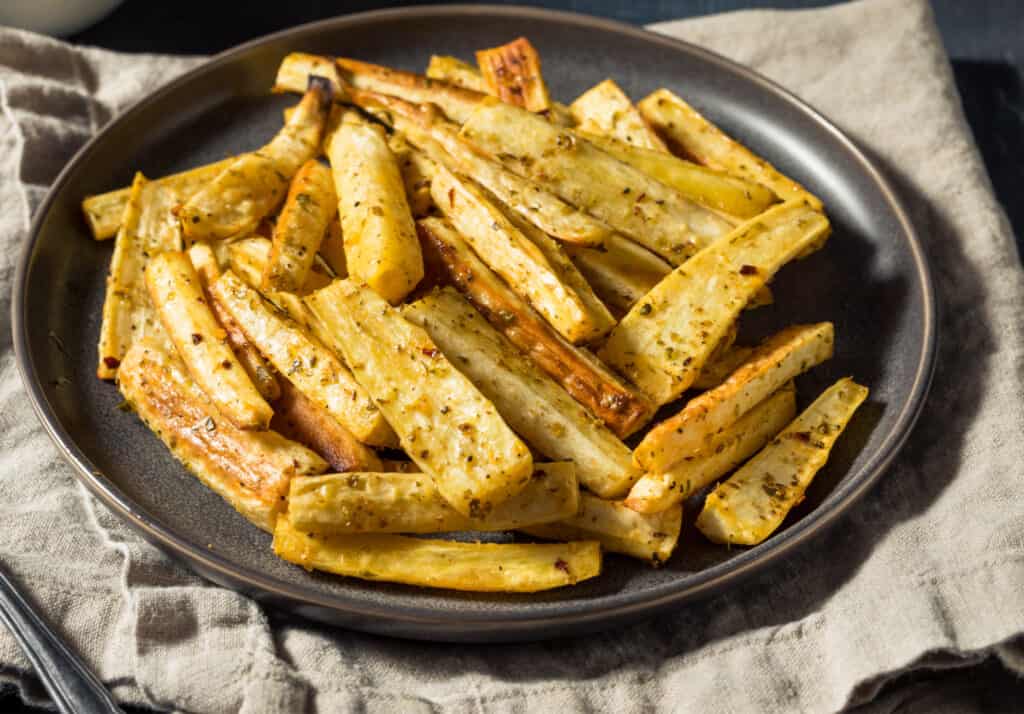
Parsnips are usually grown as an annual root crop. Unfortunately, they can prove to be a somewhat challenging crop for beginners. Getting the seeds to germinate takes a special touch. But if you put the work in at the start, once they start to germinate, you can sit back and just watch them grow.
One of the biggest challenges with the seeds is that they lose their viability over time creating low germination rates. It’s best to order new seeds from a reputable source every year to be sure your seeds are healthy.
You can let your parsnips go to flower and collect your own seeds, but you will need to leave them in the ground significantly longer if you want to do this because they’re biennials and they won’t produce flowers until the second year. If you have limited growing space, this can be a problem.
All varieties of parsnips are from the same species of plant, Pastinaca Sativa, and they are all cream-colored both inside and out, but different varieties grow better in different regions and have varying times to maturity. Keep that in mind when selecting a variety.
· Albion – hybrid variety with a fall harvest. It matures in about 120 days from seeds and is ready to harvest once the taproot is between 10 and 12 inches.
· All-American – an heirloom variety that matures in about 95 days. Taproots are about 3 inches across the top and about a foot long. This variety can be overwintered in regions where the ground doesn’t get cold enough to freeze.
· Gladiator – a hybrid, quick germinating variety that matures in about 110 days. It will be ready to harvest when the taproot is about 7 inches long.
· Javelin – this hybrid variety is intended to overwinter for a spring harvest and matures in about 110 days when it is 10 inches long.
· Sabre – a hybrid variety that can actually grow up to 5 feet. Although, you may need to dig extra deep to harvest it.
· The Student – an heirloom variety that originated in England. It can grow up to 3 feet deep in the ideal soil, but in most cases it’s ready to harvest at 15 inches, in 95 to 125 days.
· Tender and True – this variety is an RHS Award of Garden Merit winner that matures in about 150 days. It’s best harvested in fall or winter so you’ll need to plant in the spring.
· Warrior – a hybrid variety that matures in about 105 days and should not be overwintered. Harvest when it’s 10 to 12 inches long.
· White Spear – an open-pollinated variety best known for uniformity and strong growth. It will mature in 120 days and is best harvested at 10 to 12 inches.
Seed, Bulb, or Plant?
Parsnips are planted as seeds, directly sown in the ground. You won’t want to start seedlings for planting. Seeds only retain their vitality for a year or two so it’s best to get fresh seeds every year from a reputable source.
What You Need to Grow Parsnips
Parsnips are a root vegetable and will require good soil in order to take hold and thrive. Loose soil is best, as this will allow them enough room to grow. Parsnips also do well after a fall frost making them ready to harvest around the fall to early winter. Most varieties should be planted in the spring or early summer as they can take anywhere from 95 to 125 days to mature depending on the variety.
Parsnips also prefer full sun but they can tolerate some shade from taller crops.
Before planting you’ll need to prepare the bed by loosening the soil up to a foot deep since most varieties can grow up to 12 inches. Make sure tocks, twigs, and weeds are removed from the soil.
When to Plant Parsnips
Depending on your region and the variety you choose, planting season may vary.
In cooler climates, plan to sow seeds as soon as the soil is workable in the spring and reaches at least 50°. Seeds germinate best between 50° and 70° F. Even with perfect conditions, parsnips can take a long time to germinate and mature so planting sooner rather than later is best. Germination will take up to 3 weeks, longer if the soil is cooler.
In warmer climates, seeds can be sown a little later if you live in an area where the soil doesn’t freeze. Sowing seeds around the first of July, give or take a week, is perfect for a winter harvest. You’ll want the parsnips to experience some of the winter cold to help sweeten them up. Some varieties can be overwintered in warmer climates for a spring harvest.
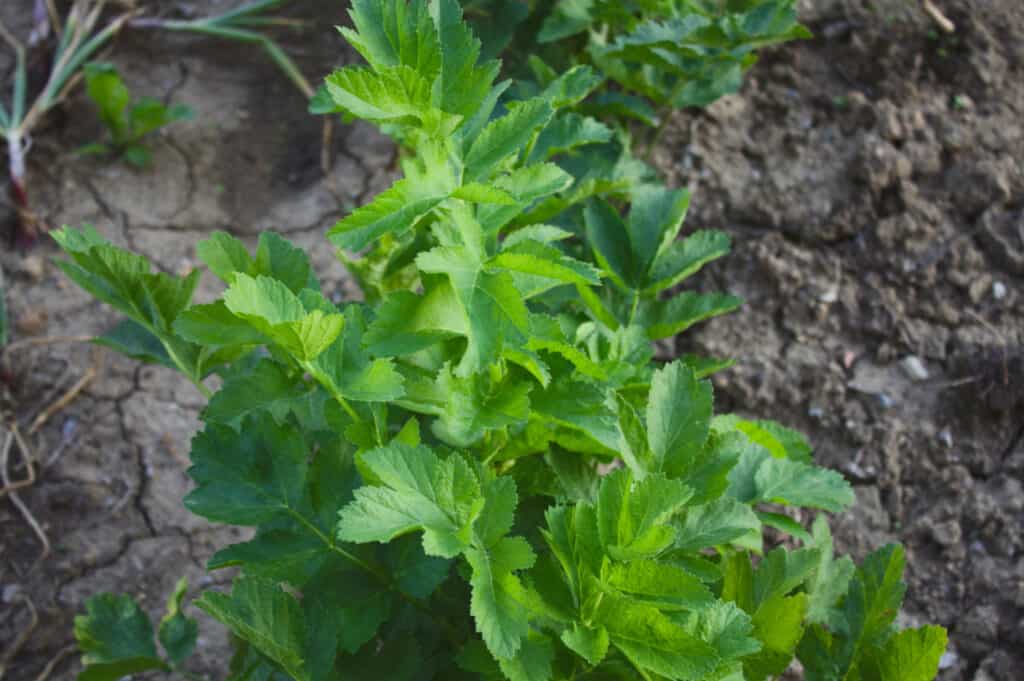
Temperature
The seeds will germinate best when the soil is between 50° and 70° F. If you’re planting in the summer for a fall/winter harvest, you can help the soil stay cooler with mulch or other ground covering. Once they germinate, you’ll want to wait for cooler weather to harvest; parsnips will get a little extra sweetness from a fall frost.
Sun
Parsnips prefer full sun but they’ll tolerate partial shade from other crops. If possible, plant in an area that receives full sun throughout the day.
Soil
Parsnips prefer a loose, rich soil. Since they’ll be growing underground and need plenty of space for growth, you’ll need to loosen the soil up to 12 inches deep and remove any rocks, twigs, or roots before refilling with soil to plant seeds. Amend the soil with a good amount of compost or organic matter to provide nutrients for the soil. The perfect pH for your soil is between 6.0 and 7.0.
Water
Parsnips will germinate and grow best in soil that is moist but not wet. In loamy soil, water about an inch per week including rain water. If the soil is quick draining and sandy, try to water up to 2 inches a week including rain and supplemental watering.
Fertilizing
An all-purpose fertilizer worked into the soil before planting will help support the growth of the parsnips.
Support
Since parsnips grow underground with only stems and leaves above ground, they don’t require a support system. Just plenty of depth.
How Much to Plant
Depending on how often you want to enjoy them and what you think your family will eat, you should plan to plant 5 to 10 plants per person in your household.
How Long Do Parsnips Take to Grow?
The amount of time it takes parsnips to mature depends entirely on the variety you choose, but most will be ready to harvest in 95 to 125 days.
How to Plant Parsnips
Before planting, you’ll need to prepare your garden site. Start by loosening the soil as deep as 12 to 14 inches to give the parsnips plenty of room for growth. Remove any rocks, twigs, roots or any other kind of clump in the soil. The plants will need a sunny area that drains well and is free of obstacles.
After loosening the soil, mix in 2 to 4 inches of compost, organic matter, or aged manure to fertilize the soil and the parsnips.
It’s best to sow seeds directly in the soil. Transplanting root vegetables can cause them to be mishappened and stunt their growth. Seeds can be planted 3 per hole and then thinned out as they grow since not all seeds will germinate. You can plant up to 9 seeds per square foot.
Once the soil is prepared, you’re ready to plant. Be sure your seeds are fresh, no more than a year old or they won’t germinate.
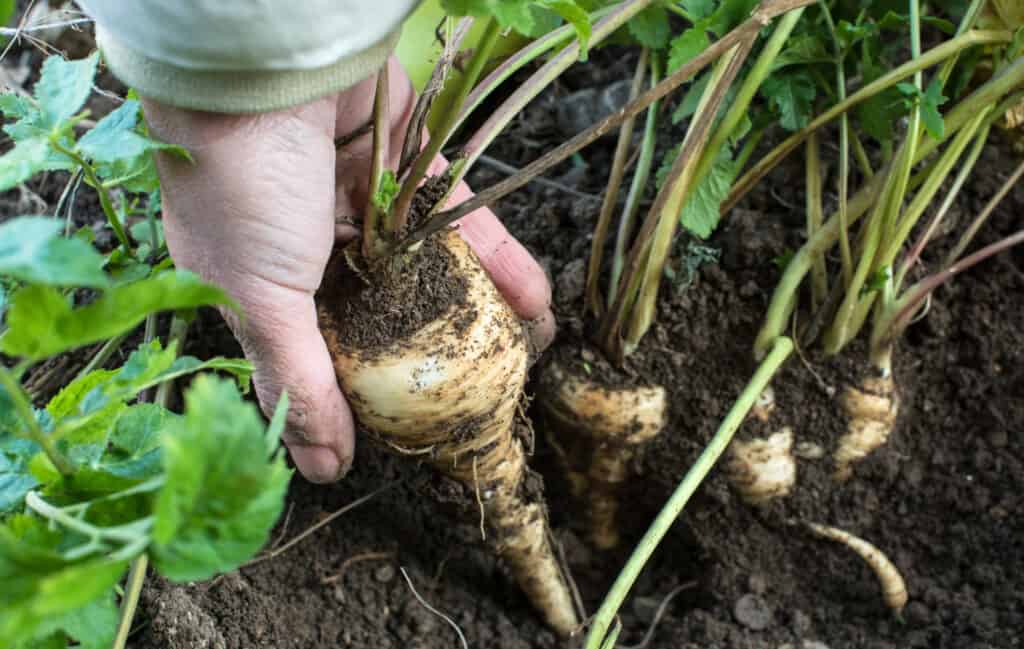
Spacing
Seeds should be sown about an inch apart in rows that are 18 to 24 inches apart to allow for growth.
Depth
Sow seeds about 1/2 inch deep.
Growing Tips for Parsnips
· Sowing radish seeds between your parsnips will easily mark the row and break the soil for the parsnips as they grow quickly.
· Parsnips germinate slowly and can take 2 to 3 weeks to germinate, longer if the soil temperature is below 50° F. You can speed up germination by laying the seeds in a damp paper towel for a day or two before planting then keeping the soil moist.
· Once the seedlings are 2 to 3 inches tall, thin them out so they’re spaced 3 to 4 inches apart. It’s best to do this by snipping off the top instead of pulling them out of the soil so you don’t disturb the remaining seedlings.
· Row covers help to deter pests.
· Keep the garden bed free of weeds, especially when the plants are young. A layer of mulch will help deter weeds and help the soil retain moisture.
· Be sure to keep the plants watered in the summer heat if your area doesn’t receive enough rain.
· If you fertilize the soil before planting, it’s likely you won’t need to fertilize again. Excessive nitrogen will encourage more growth on the top instead of the root.
· Once the roots start to form, hill the soil around the plants’ base, this will prevent any greening of the root’s shoulders.
· Take care when handling parsnips. The sap and leaves can be irritating to the skin so be sure to cover arms and legs and wear gloves when weeding and harvesting.
· A couple of frosts are good for parsnips, it will make them sweeter but harvest before the ground freezes for the winter.
How to Harvest Parsnips
Check the maturity of your variety on the seed package, but your parsnips should be ready to harvest in 95 to 125 days. Leave them in the ground for a few frosts but be sure to harvest before the ground freezes.
You can also leave them in the ground all winter but cover the soil with a thick layer of mulch and harvest immediately when the ground thaws before top growth starts.
Parsnips will be ready to harvest when the roots are at least 1 inch in diameter. To harvest, simply pull the root out of the soil.
How to Store Parsnips
Before storing, be sure to trim any foliage down to no more than 2 to 3 inches. Parsnips are best stored between 32° and 35° F with humidity of 90 to 95%. If you plan to store longer, up to 6 months, store in slightly damp sand, sawdust, or leaves.
Diseases and Pests to Watch Out For
Like other fruits and vegetables in your garden, parsnips are susceptible to some pests and diseases. A few to watch out for include:
· Carrot Rust Fly – tiny black flies with orange heads, they will lay eggs in the soil near the base of the plant, the larvae will feed on the parsnip roots. They can overwinter in the soil so rotate your crops each year to keep them away.
· Willow-Carrot Aphids – pale green or yellow pests, they will attack the plant foliage and spread virus. Using row covers will help to keep them off your plants. If you find them, blast them off with the hose.
· Cutworms – these feed on roots and stems and will overwinter as eggs and larvae. If you know they’re a problem in your garden, turn up the first couple of inches of soil a few weeks before planting to expose them to birds.
· Armyworms – these moth larvae bore into the roots. Handpick any eggs that are on the stems and under the leaves. Row covers are a good choice to keep them away.
Parsnips are a tasty and healthy addition to your garden and, once planted, they can be fairly easy up until harvest. I hope you found this guide on how to grow parsnips for beginners the help you need to add this fun root vegetable to your garden this growing season.
More How to Grow Resources:
How to Grow Parsnips for Beginners
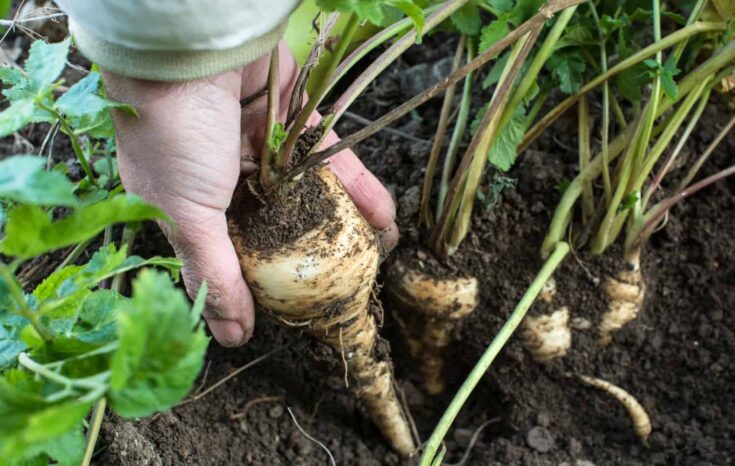
How to grow ripe parsnips in your own backyard that are perfect for soups, stews or even side dishes. Get planting tips and care so you are growing big and flavorful parsnips this year. How to grow parsnips step by step from planting to harvest.
Materials
- Parsnip Seeds
- Water
- Fertilizer
- Manure or Compost
- Mulch or other ground covering
Tools
- Garden
- Rake
- Hoe
- Shovel
Instructions
- Prepare your garden site by loosening the soil as deep as 12-14 inches. Remove any rocks, twigs, or roots.
- Mix in 2-4 inches of compost or manure, into the loose soil.
- Sow the seeds directly in the soil, 18-24 inches apart and 1/2 inch deep.
- Water about an inch per week including rain water.
- Once seedlings are 2-3 inches tall, you will want to thin them out so they are 3-4 inches apart. Best to do this by snipping off the top instead of pulling them out of the soil. This prevents disturbing the remaining seedlings.
- Once the roots start to form, hill the soil around the plants base.
- Once the roots are at least 1 inch in diameter, you may harvest by simply pulling the root out of the soil.
- Before storing, be sure to trim any foliage down to no more than 2-3 inches.
- Store parsnips between 32° and 35° F with a humidity of 90-95%.
Notes
- The plants will need a sunny area that drains well and is free of obstacles.
- Parsnips prefer full sun. Plant in an area that receives full sun throughout the day.
- Make sure your seeds are fresh. Seeds a year or older won't germinate.
- The perfect pH of your soil for parsnips is between 6.0 and 7.0.
- Parsnips will germinate and grow best in soil that is moist but not wet.
- Growing radish seeds between your parsnips will easily mark the row and also help break the soil for the parsnips so they may grow quickly.
- Take care when handling parsnips. The sap and leaves can be irritating to the skin so be sure to cover your hands, arms, and legs while working with them.
- A couple of good frosts are good for parsnips as it will make them sweeter. Be sure to harvest them before the ground freezes completely for the season.
- You may leave your parsnips in the ground to grow all winter, but you will want to cover the soil with a thick layer of mulch and harvest immediately when the ground thaws to prevent top growth from starting.
- If you plan to store longer, up to 6 months, store in slightly damp sand, sawdust, or leaves.
Recommended Products
As an Amazon Associate and member of other affiliate programs, I earn from qualifying purchases.


